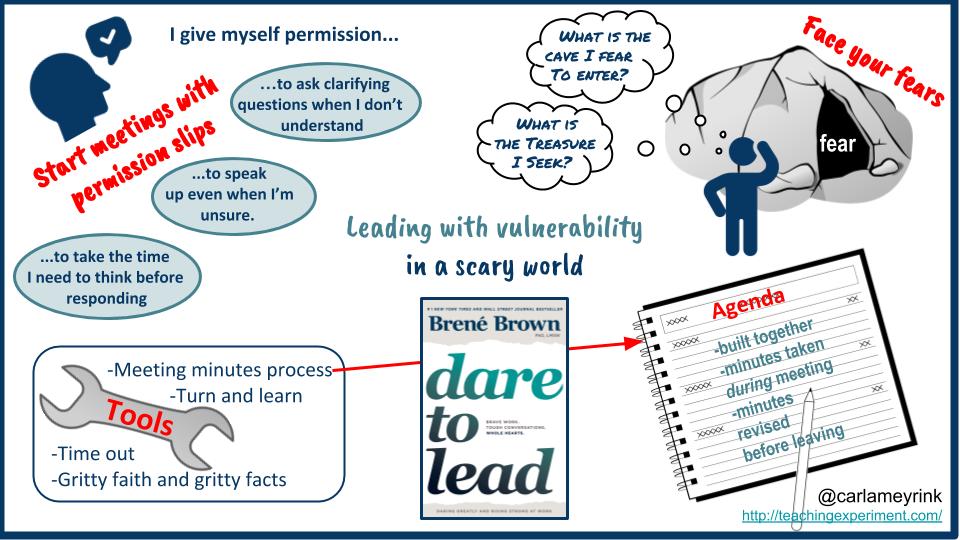Improving Meetings with Dare to Lead by Brené Brown

When I first heard of Brené Brown’s latest book, Dare to Lead, it called to me. The moment I saw it, it went to the top of my rather tall pile of professional reading. Maybe because I love all things Brené — her book Daring Greatly, her TED Talk, her podcasts, her Netflix documentary. Or maybe it was quite simply because I love books on leadership and, hey, the cover of Dare to Lead shares the colors of our school logo. But in any case, I devoured this book over the summer (twice).
Since school started recently, I’ve slowly begun to put her ideas into practice. I’m not going to write about my takeaways from the entire book — because there are simply too many. This book is dense. It’s packed with information. I suggest that if you read it, you take it slow, digesting it bit by bit. Brené has a workbook on her website to help you take in all this information. There’s even one for educators!
So… here’s my reflection on how I implemented the ideas from the book’s Section Two: The Call to Courage.
For our first directors’ meeting this year, I introduced the protocol from Dare to Lead and asked if everyone would like to try it. Our team was on board, so we began.
These are the steps we took:
- Shared agenda: Before the meeting, we shared an agenda on Google Drive where everyone could jot down topics they wanted to cover.
- Time limit: We decided how long the meeting would be and set an alarm for 5 minutes before the meeting ended to review the meeting minutes (see below).
- Permission slips: At the start of the meeting, we each wrote a permission slip for ourselves. These slips can include anything that you normally have difficulty with or need to remember, like “I give myself permission to listen attentively,” or “I give myself permission to share my ideas even though I don’t feel secure about them.”
- The hard part: Before starting the meeting, we shared our permission slips with one another. This is an act of vulnerability, but don’t skip it — it changes everything.
- On-the-go meeting minutes: One person volunteered to take the minutes during the meeting (not when it was over) while the rest of us jotted down notes for ourselves.
- Revised minutes: When the alarm went off five minutes before the meeting’s end, we read through the minutes and revised them together, making sure we all agreed with what was written. We used to write up our minutes hours (or even days) after the meeting happened, and they were inevitably one person’s understanding of what we talked about. By reviewing our minutes before we leave we can make sure we’re all on the same page about what we discussed, what our next steps will be, and decisions we made.
That doesn’t seem like a huge change, does it? And yet… the result was magical.
The impact:
- Because we all helped build the agenda, we all felt like equals. No one was in charge of the meeting. It belonged to all of us.
- Setting an alarm for the end of the meeting made us aware that we couldn’t waste time. Anytime we started to drift off-topic, one of us would say, “Oops, we only have 20 minutes left and we still have a lot to cover. Let’s get back on track.”
- Taking the time to write a permission slip put us each into a mindful space. It helped draw us into the meeting and somehow take it more seriously.
- The sharing of permission slips made us all feel a little shy and vulnerable, despite having known each other for over eight years. But the sharing helped us gain a deeper understanding of each other. I had no idea that a couple of our team members struggled with feelings of insecurity when speaking up or that others felt anxious and couldn’t focus. Because of this sharing we were all so much gentler and kinder with each other. We used phrases like, “Oh, I’m sorry, I didn’t mean to interrupt you,” or “Could you explain that please? I’m not sure I understood what you meant.”
- Reviewing the minutes at the end of the meeting helped us clarify decisions and make sure that we all agreed on next steps.
It was, by far, the best meeting we’ve ever had. Not only did we cover everything we intended to, but we were respectful of all ideas and opinions and we were mindful of supporting one another. This may seem like a lucky coincidence, but a few days later I sat in on a meeting run by one of our director’s with her leadership team. She was using the same techniques and her meeting also had an overarching tone of kindness and community. And, folks, this is only one chapter of the book! The rest is loaded with helpful tips, techniques, word choice and tone.
Brené Brown’s book is an incredible resource that I recommend to everyone. After all, no matter what our role is, we can all be leaders.
If you’ve already read Dare to Lead, I’d love to hear your takeaways from the book.

Leave a comment